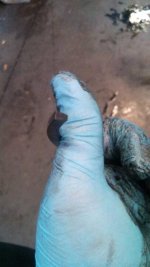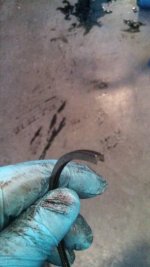You are using an out of date browser. It may not display this or other websites correctly.
You should upgrade or use an alternative browser.
You should upgrade or use an alternative browser.
Hone pattern, rockwell hardness, ring tension
- Thread starter Fahlin Racing
- Start date
biggy238
Active member
- Joined
- Aug 3, 2008
- Messages
- 11,005
Don't ask me..... I dont know chit!
Oh, but you do.
I wasn't questioning you. That wasn't my intention. I didn't have a chance to read your link. I was glad to see you back in the thread.
I just thought we were talking about the same means to an end.
The reason I asked about other mechanisms in the design is because I think I've seen patterning in the bottom of the compression rings on a couple of applications.
From my Not-So-Smart phone
Fahlin Racing
New member
- Joined
- May 9, 2012
- Messages
- 469
I will see if I have anything worth posting on diesel specific as well besides longevity and high heat resistance. Food for thought, look at the ring locations between a gas and diesel. I remember reading an article Smokey had written that the early days of racing the rings sat quite a ways down from the crown-top much like the diesel ring packages are.
Looking forward to what you have in the garage Biggy.
Looking forward to what you have in the garage Biggy.
Last edited:
Fahlin Racing
New member
- Joined
- May 9, 2012
- Messages
- 469
I would say the keystone is only built to low rpm. You not only have what Paul says, but you have tapered sides with a point which can act as a pivot point if the wall (our bearing suface) becomes disrupting and effecting out stability.
Here is Goodson Engine's listings for stones
http://www.goodson.com/Goodson_Honing_Stones
Here is Goodson Engine's listings for stones
http://www.goodson.com/Goodson_Honing_Stones
Fahlin Racing
New member
- Joined
- May 9, 2012
- Messages
- 469
Are there any blocks, Cummins, Powerstroke or Duramax that have higher nickel in them? In the sense of the SBCs that had a rating of 020 over the 010 castings?
justthinking
New member
- Joined
- Oct 3, 2013
- Messages
- 2
justthinking
Honing an sleeve/block is more complicated and important than most of us realize. Size and true are as important as the hone technique. Heat created during the honing process must be accounted for. Super important! Hone finishes are determined by type of material of sleeve/block and type of ring package used. The Abbott/Firestone curve shows the load bearing extent of the cylinder finish. Ra (one value used for surface finish) does not tell the whole story. Rings have a tough environment to survive in. For a insight into what all happens read the Honing document.
qualityperformancecams.com
look under the Cam Science & Technology page
Honing an sleeve/block is more complicated and important than most of us realize. Size and true are as important as the hone technique. Heat created during the honing process must be accounted for. Super important! Hone finishes are determined by type of material of sleeve/block and type of ring package used. The Abbott/Firestone curve shows the load bearing extent of the cylinder finish. Ra (one value used for surface finish) does not tell the whole story. Rings have a tough environment to survive in. For a insight into what all happens read the Honing document.
qualityperformancecams.com
look under the Cam Science & Technology page
Fahlin Racing
New member
- Joined
- May 9, 2012
- Messages
- 469
Thank you for the website.
From whats been covered thus far, would you happen to have anything to add in addition to your suggestion to read?
From whats been covered thus far, would you happen to have anything to add in addition to your suggestion to read?
justthinking
New member
- Joined
- Oct 3, 2013
- Messages
- 2
Keystone rings work well only when used in the designed size / clearance intended. Extra bore clearance changes the ring side taper to piston ring land clearance. To much ring movement to seal on the ring land equals more blowby and delays the ring seal to the oil film on the cylinder wall. Delayed ring seal means more loss of compression. Boosted engines respond well to extra top ring gap clearance to allow for ring expansion. Second ring end gap then becomes very important. The lowest tension ring possible that seals the bore (round and true) will provide the best result. Round and true bore will dictate how low of tension the ring can still seal with. Ring flutter control will decide effectiveness.
biggy238
Active member
- Joined
- Aug 3, 2008
- Messages
- 11,005
Fahlin Racing
New member
- Joined
- May 9, 2012
- Messages
- 469
Do they make ring shims for keystone rings at all?
Fahlin Racing
New member
- Joined
- May 9, 2012
- Messages
- 469
I am sure when you see gap increases, the increase shouldn't be too large because we must keep "seated" so I guess trial and error here is absolute. I wonder if anyone has ran gas-ports on a full-on race mill here?
Fahlin Racing
New member
- Joined
- May 9, 2012
- Messages
- 469
Has anyone here seen a end gap too large that busted the ring lands on these? Have you seen any busted ring-lands Matty on those fleet engines you maintain? What about you Biggy?
Fahlin Racing
New member
- Joined
- May 9, 2012
- Messages
- 469
Jumping back to Paul's post on piston to wall clearance, are you speaking of the less expanding cast pistons? Forged units expand quite a bit more than the cast units.
biggy238
Active member
- Joined
- Aug 3, 2008
- Messages
- 11,005
Starting fluid and other overpressure situations. Mis-installation.
Nothing even a performance engine should encounter.
It might be worth mentioning that even aluminum crowns typically have "steel" ring land inserts.
From my Not-So-Smart phone
Nothing even a performance engine should encounter.
It might be worth mentioning that even aluminum crowns typically have "steel" ring land inserts.
From my Not-So-Smart phone




